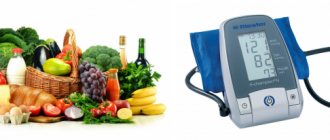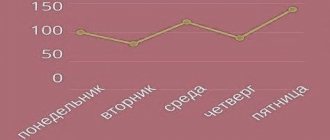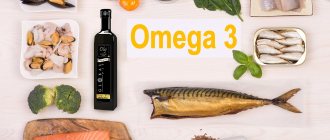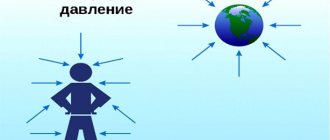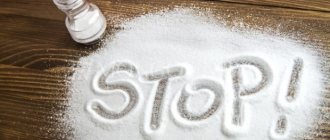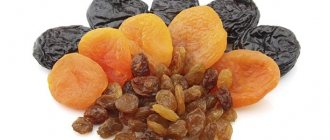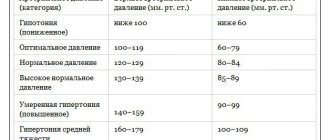Processes associated with an increase in blood pressure are symptoms of a specific disease or an independent disorder of vascular tone regulation.
In the latter situation, the disorder is called hypertension and has its own code according to the ICD, that is, it is recognized as a separate deviation.
To correct this condition, you need to change your lifestyle, give up bad habits and, of course, adjust your diet.
Basic metabolic processes, as well as water-salt metabolism, and, ultimately, blood pressure indicators largely depend on the quality and nature of nutrition.
If we talk about menu selection, the issue is decided at the discretion of the patient himself. It is better to exclude some foods altogether, while others, on the contrary, should be included in the diet.
A good solution would be to consult with a specialized specialist, a nutritionist. He will help develop nutritional principles. Or, in extreme cases, a doctor who conducts his activities on issues with the patient’s hormonal background - an endocrinologist.
Otherwise, it is recommended to adhere to the list below.
Citrus
The most preferred are lemons, oranges, and grapefruits. The beneficial therapeutic effect is based on the ability to influence the state of the cardiovascular system:
- Large amounts of ascorbic acid or vitamin C help protect arteries and capillaries from destruction. Increases elasticity, helps to better tolerate any load. This is especially important for patients suffering from hypertension.
- Flavonoids help thin the blood. In addition, these specific compounds affect metabolic processes in the body. This means that all citrus fruits can be used to prevent atherosclerosis. Of course, in moderation.
Products that lower blood pressure, such as oranges, tangerines, and grapefruits, can be used in their pure form or juiced from them.
Lemon contains a lot of acid, making it much more difficult to consume. If desired, you can add a slice to lukewarm tea. Not hot. Vitamin C does not tolerate overheating and is destroyed.
Causes of high blood pressure
There are 6 significant reasons why a person is susceptible to high blood pressure or hypertension:
- Violation of vascular tone. Hypertension will be an independent disease. Signs of occurrence are pressure surges, poor health. The patient is prescribed an examination, during which a blood and urine test will be taken. An electrocardiogram of the heart is prescribed, an ultrasound of the insides and a chest x-ray are performed. If the diagnosis is confirmed, the doctor prescribes medications, diet and special exercises to tone the blood vessels.
- Kidney disease. Disturbances in the urinary system lead to high blood pressure. This means that the kidneys do not perform their functions, the patient experiences swelling of the face and limbs. Additional symptoms are pain when going to the toilet, blood and urine sampling is necessary, the result will show inflammation.
- Hormonal problems. Pressure increases as a result of improper metabolism; a malfunction in the water-salt system occurs in the human body. The composition of the blood changes, the load on the vessels increases.
- Hypertension acquired as a result of treatment for another disease. Blood pressure increases due to taking cough medications and anti-inflammatory drugs.
- Failure to follow a diet, poor nutrition. By consuming foods containing large amounts of salt, a person acquires hypertension. Salt is found in fish, smoked and salted lard, pickled vegetables, sausages, salted cheeses, delicacies, and canned foods. In addition to these products, people suffering from high blood pressure should not drink beer, coffee, strong alcohol, soda, chips, crackers and fast food. All these products contain a high percentage of salt.
- Spinal disease. Usually this is osteochondrosis, a back injury. Leads to problems with muscle tone and vasospasm. To determine the disease, it is necessary to undergo an x-ray of the spine.
Vegetables
Several names can be included here.
- Beet. Like the previous group, it contains a lot of ascorbic acid, which acts as an antioxidant. Prevents changes in the vascular wall and its destruction and degeneration.
In addition, this healthy vegetable contains potassium. An important element for maintaining electrolytic balance and regulating vascular tone.
There is no need to abuse it, since the vegetable has a pronounced laxative effect and provokes intestinal disorders if used excessively.
- Garlic. Contains allicin, an important ester compound. It is this that gives the vegetable its sharp taste and creates a burning sensation. Promotes reflex relaxation of the walls of blood vessels (thereby lowering pressure), then, when absorbed, helps consolidate the result.
In addition, the product has a diuretic effect, although not strong. Eliminates excess water from the body. At the same time, with excess consumption it provokes the opposite effect. 1-2 cloves per day is enough.
- This also includes spinach. It contains many vitamins, as well as magnesium and potassium. Important electrolytes that help equalize blood pressure and restore vascular elasticity.
DASH diet for hypertension
Dietary Approaches to Stop Hypertension (DASH) – The effectiveness of nutrition is confirmed by the results of clinical studies of volunteers. Tests have shown that blood pressure after two weeks of following the diet decreases on average by 6-11 mmHg. Art.
A diet for hypertension is especially effective in the first stage; it can delay or completely eliminate the transition to drug therapy.
Basic principles of nutrition:
- salt limitation to 5 g/day, for chronic hypertensive patients suffering from frequent edema up to 2 g/day;
- replacing wheat and white bread with grain, bran, pasta and brown rice;
- Only dietary types of meat and fish are allowed: veal, chicken fillet, cod, haddock, pollock, no more than 100 g/day;
- the diet must include cereals, sprouted grains of wheat, alfalfa;
- replacing animal fat with vegetable fat;
- low-fat dairy and fermented milk products;
- inclusion of legumes and seeds in the menu: boiled beans, soy side dishes, lentils, pumpkin seeds, sunflower seeds, a total amount of up to 400 g/week;
- fruits up to 300 g/day, vegetables up to 600 g/day.
The difference between this diet and table No. 10 is the lower calorie content of the daily diet, 1800-2000 kcal/day, which helps to lose extra pounds.
It should be added that the DASH diet for hypertensive patients is not intended for weight loss. Losing extra pounds is more of a beneficial side effect. This diet is recommended for obese patients. It has been reliably proven that there is a direct connection between high blood pressure and excess body weight. It has been proven that losing 1 kg of weight causes a decrease in blood pressure by 1 mm Hg. Art.
A prerequisite for achieving lasting results is complete cessation of bad habits (smoking, alcohol) and daily physical activity.
Drinks that lower blood pressure
Tea. Just not black, as it has the opposite effect. Hibiscus (red) or green are best suited. Although the question regarding the latter remains quite controversial in medicine.
This drink is not recommended for patients with impaired renal function or insufficiency, since there will be an increase in blood pressure against the background of dysfunction and increased load.
Otherwise, this tea is very useful. It contains tannins, flavonoids, and other elements. Together, they give blood vessels their former elasticity, protect them from destruction, increase the speed of blood flow, and fight excess lipids, in particular cholesterol.
A combination of tea with ginger and lemon works well. You can add a small amount of honey to improve the taste. The main thing is that the drink is not hot.
High-quality cocoa gives approximately the same results. The powder contains a lot of magnesium; when using milk for preparation, the patient also consumes calcium.
In the system, these components help stabilize blood pressure levels. Although they do it gently. For patients with hypertension, the drink is allowed, but you should not count on a significant therapeutic effect.
For healthy people, cocoa can be recommended as a measure to prevent blood pressure surges.
The drink additionally has natural sedative and antidepressant effects. This means that the factor of possible increase in blood pressure – stress – is stopped.
Clinical picture
Hypertension is a pathology of the cardiovascular system, characterized by a persistent increase in blood pressure. Today, every third person on the planet suffers from the disease (mostly people in the older age group).
Content:
- Clinical picture
- Basic principles of nutrition
- Products that lower blood pressure
- Treatment menu
- Bee products against hypertension
- Conclusion
The unit of measurement for blood pressure is considered to be millimeters of mercury. The value of arterial indicators is expressed by two numbers: the larger (systolic) and the smaller (diastolic). Moreover, the first value is recorded during maximum contraction of the heart muscle, and the second - at the moment of complete relaxation of the myocardium.
Normally, systolic pressure varies between 100 - 125 millimeters of mercury, diastolic in the range of 70 - 85. If these indicators exceed 140 (upper) and 90 (lower) units, arterial hypertension occurs.
In the pharmaceutical industry, it is customary to distinguish between 3 degrees of severity of pathology.
Mild (preclinical)
This stage of the disease is characterized by frequent abrupt pressure drops (short-term). At the same time, the systolic indicator varies in the range of 140 - 159 units, and the diastolic in the range of 90 - 99 units.
To correct preclinical hypertension, it is advisable to use folk remedies (since medications are not required).
Moderate (borderline)
The second degree of pathology is accompanied by an increase in upper pressure to 179 millimeters of mercury, and lower pressure to 109 units.
To reduce arterial values, pharmaceuticals (hypotonic drugs) are used. In the absence of proper therapy, a hypertensive crisis is possible, since the indicators remain at the borderline (upper) level for a long time.
Severe (chronic)
At the 3rd stage of the disease, systolic pressure exceeds 180 units, and diastolic pressure exceeds 110. Arterial parameters can only be stabilized with the help of medications.
If the disease is not stopped for a long time, irreversible changes develop in the “target organs” (kidneys, heart, brain, fundus vessels). At the same time, uncontrolled hypertension entails severe complications (strokes, encephalopathy, heart attacks, cognitive disorders, dementia, renal failure, etc.).
Symptoms characteristic of the first two stages of the pathology:
- dizziness;
- tinnitus (fullness);
- headache;
- fatigue;
- irritability;
- puffiness of the face;
- insomnia;
- “double vision”;
- swelling of the eyelids.
At the third stage of pathology, the following disorders occur:
- pain in the heart area;
- nausea;
- feeling of lack of air;
- tachycardia;
- redness of the skin;
- impaired coordination of movements;
- cognitive disorders (decreased memory, attention);
- blurred vision;
- "weakness" in the limbs.
Remember, timely diagnosis of the disease will help avoid serious complications: stroke, heart attack, heart failure.
Spices and seasonings
Ginger has blood pressure-normalizing properties. Although formally it cannot be attributed to this group. This is a full-fledged independent product.
- The substances based on it thin the blood, acting as a natural antiplatelet agent.
- In addition, they help relax the vascular muscles, preventing further spasm and an increase in tonometer readings.
Turmeric is called a good help in prevention and even therapy. The substance of the same name in its composition helps to quickly reduce blood pressure, but gently, and therefore does not create health risks.
Hot cayenne pepper. He's chili. The product is used to rapidly reduce blood pressure. This is a reflex response to the use of capsaicin, which the product is so rich in.
But this can be dangerous, since a sharp jump in blood pressure does not affect the condition of the blood vessels (their elasticity). Pepper is allowed for hypertensive patients, but it should be eaten with caution.
Fruits other than citrus
Pomegranate has special antihypertensive properties in this group. It is best to use its juice; drinking 50 grams of this healthy product per day is enough.
The fruit contains vitamin C and a lot of other active components. You can also find specific compounds that inhibit angiotensin, a component that affects the constriction of blood vessels and provokes their artificial spasm.
Potassium and magnesium complement the picture, acting as regulators of water-salt metabolism, and a slight diuretic effect is possible.
Recovery is achieved relatively slowly. After about six months to a year, it is possible to achieve a persistent drop in pressure levels by 7-15 units.
Because of these properties of pomegranate, it is prohibited for people with hypotension to consume it. Low blood pressure or a tendency to it. It may be dangerous. In small quantities and irregularly - at the discretion of the doctor and with his permission.
Another help can be called chokeberry. It should not be used for food purposes precisely because of its ability to sharply lower blood pressure readings.
At high blood pressure levels, this is a threat, since the risks of heart attack, stroke, and other emergency conditions rapidly increase.
Bananas help enrich the body with potassium. The fruit is suitable for lowering blood pressure, but is not recommended in large quantities for diabetics due to the starch.
How does food affect?
Any food is a set of substances. Most of them are useful to humans, some are harmful, and with some it is more complicated - they can be useful and harmful depending on the situation, harm in large quantities, etc. Everything a person eats affects him individually, and the same applies to drinks. On a note! Foods can both increase and decrease blood pressure, as well as contribute to conditions in the body that cause blood pressure levels to change.
This can happen both in the long term and instantly (for example, if you drink coffee, your blood pressure will increase immediately). If you are careful when eating, food will only be a secondary, minor factor for blood pressure. If you abuse certain foods and drinks or use them intentionally in order to even out the indicators, the result will be more noticeable.
Spicy food
Spicy food itself - any dish with the addition of a variety of peppers and spices - has no effect on blood pressure.
However, recent studies show that spicy foods significantly reduce a person’s cravings for salty foods, and this is one of the main reasons not only for high blood pressure, but also for problems with excess weight.
Salt retains water in the body, which affects blood pressure, increasing it. This is why in diets for hypertensive patients there are such strong restrictions on salty foods and salt itself - so as not to aggravate the situation. The main problem with salt is that a person who is accustomed to heavily salting food finds it very difficult to give up this habit - the taste buds are already accustomed to a certain salt content.
Important! Despite this effect, you should not abuse spicy food - it is harmful to the heart, as well as the stomach and digestion in general.
Spicy food “distracts” them from salt deficiency due to a brighter taste, and also partly due to substitution - the receptors for the perception of salty and spicy are nearby, therefore eating peppery food can deceive the desire for salty.
Pomegranate
Pomegranate is, in general, a very healthy fruit, but for some reason it is credited with both real and not real beneficial properties for the human body. The effect on pressure belongs to the first group - pomegranate lowers it.
In general, this is a fairly useful quality - a person with high blood pressure can include this fruit in their diet, thereby slightly improving their daily well-being. But a person with low blood pressure can suffer from even one pomegranate, not to mention its systematic use.
It is not advisable for hypotensive patients to consume pomegranates (or in very small quantities occasionally), but for everyone else it will be very useful, especially for people with the opposite problem - hypertensive patients.
Interesting article: Blood pressure after eating: is it possible to measure it immediately after eating and how long after it should be measured?
Dairy products
Kefir and milk. You need to drink at least one glass of drink a day. Natural, with a minimum percentage of fat content (about 1.5-2).
It is not recommended to buy ultra-pasteurized types because they contain a lot of sugar. This is a ploy by manufacturers to get consumers to pay.
The effect of using fermented milk products is delayed. However, everyone can drink it, even patients with hypotension.
Although milk and kefir lower blood pressure, they do so gently and within small limits. Basically, they enrich the body with calcium if it is sufficiently digestible.
Fish
Marine. Even better - red. Although other varieties are suitable for the prevention and control of disorders.
One of the possible reasons for a stable increase in blood pressure is hypercholesterolemia.
That is, the actual increase in the concentration of lipids in the blood. As this condition develops, atherosclerotic plaques appear. Fatty deposits on the walls of arteries.
Fish contains polyunsaturated fatty acids, which naturally bind and remove harmful cholesterol.
With regular consumption of seafood-based dishes, you can achieve high-quality correction of the state of the cardiovascular system.
This also includes shrimp and other products. Not counting crab sticks and semi-finished products, saturated with salt in horse doses.
Nuts
Walnuts, hazelnuts, almonds. Contains arginine and citrulline. Both substances have the ability to remove cholesterol.
In the early stages, it is also possible to eliminate plaques based on it. In addition, they stabilize blood sugar levels.
To lower blood pressure, it is enough to eat 1-2 nuts per day. It is no longer worth it, including due to the high calorie content of the product.
Treatment menu
Monday
Breakfast: 200 g of steamed oatmeal, 100 g of assorted dried fruits (figs, dates, dried apricots, prunes).
Lunch: 150 g of fruit mousse (banana, apple, persimmon).
Lunch: 150 g whole grain pasta, 80 g goulash, 70 g broccoli salad.
Afternoon snack: 200 g of berry-curd dessert (fresh).
Dinner: 200 g fish meatballs, 30 ml sour cream,
2 hours before bedtime: 250 ml of 1% kefir.
Tuesday
Breakfast: 200 g of rice and fruit porridge (raisins, banana, dates), 70 g of rye bread (dried), 20 ml of honey.
Lunch: 150 g of berry-nut mixture (grapes, cranberries, blackberries, almonds, hazelnuts).
Lunch: 200 ml fish soup, 150 g beetroot-prune salad, 10 g garlic.
Afternoon snack: 150 g potatoes (baked or boiled), 100 g tomatoes, 20 ml camelina oil.
Dinner: 200 g buckwheat, 100 g sauerkraut, 70 g boiled turkey.
2 hours before bedtime: 250 ml of green cocktail (kefir, herbs, honey, banana).
Wednesday
Breakfast: 200 ml of chicory drink, 100 g of cranberry jam (ground with sugar), 70 g of whole grain bread (dried), 50 g of walnuts.
Lunch: 200 g curd soufflé, 50 g raisins.
Lunch: 250 g lentil soup, 100 g chopped vegetables, 15 ml flax seed oil.
Afternoon snack: 150 ml yogurt, 100 g fresh fruit (strawberries, banana, apples).
Dinner: 200 g chicken breast with vegetables (stewed), 100 g beet-garlic salad, 40 g celery leaves.
2 hours before bedtime: 200 ml of homemade serum.
Thursday
Breakfast: 150 g apple pudding with raisins, 150 ml rosehip broth, 30 ml flower honey.
Lunch: 150 g berry compote, 100 g cottage cheese casserole.
Lunch: 200 g borscht with beans, 100 g rice meatballs, 50 g vegetable mixture (tomato, cucumber, celery).
Afternoon snack: 150 g seaweed salad, 20 ml cedar oil
Dinner: 150 g mashed potatoes, 100 g zucchini-eggplant caviar, 70 g chicken cutlets (steamed).
2 hours before bedtime: 150 ml of yogurt.
Friday
Breakfast: 150 g egg omelet, 100 g sauerkraut, 70 g bacon.
Lunch: 200 ml hibiscus tea, 100 g oatmeal cookies.
Lunch: 200 g pilaf, 100 g beetroot-garlic salad, 20 ml flax seed oil.
Afternoon snack: 200 g of fruit and berry jelly.
Dinner: 250 g vegetable stew, 50 g boiled veal.
2 hours before bedtime: 250 ml of yogurt.
Saturday
Breakfast: 200 g of oatmeal, 100 g of fermented baked milk, 70 g of dried fruits (unabi, dates, raisins, prunes), 50 g of biscuits.
Lunch: 200 ml cinnamon milkshake.
Lunch: 200 g squash-eggplant caviar, 100 g bean puree, 50 g leafy greens.
Afternoon snack: 200 ml yogurt, 50 g walnuts.
Dinner: 250 g of green buckwheat, 150 g of boiled vegetables (eggplant, beets, zucchini, carrots), 70 g of chicken steak (baked).
2 hours before bedtime: 200 ml of serum.
Sunday
Breakfast: 200 ml cocoa, 70 g bran bread, 50 g cheese, 30 g butter.
Lunch: 200 g seasonal berries, 50 g almonds.
Lunch: 150 g jacket potatoes, 100 g cauliflower in batter, 100 g baked turkey, 15 ml camelina oil.
Afternoon snack: 200 ml mint tea, 150 g oatmeal-curd casserole.
Dinner: 150 g fish steak (stewed), 100 g vegetable mixture (tomatoes, celery, peppers, cucumbers, garlic).
2 hours before bedtime: 200 ml of kefir.
